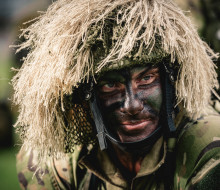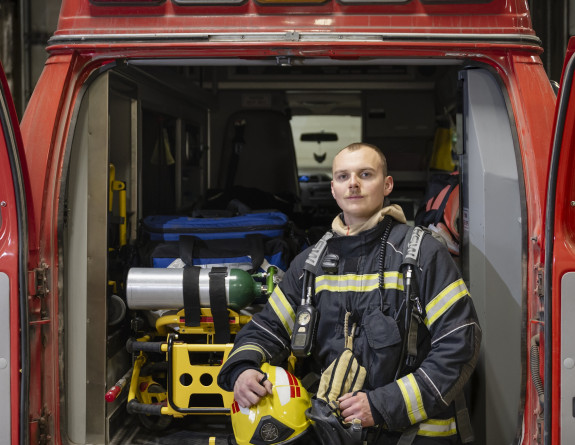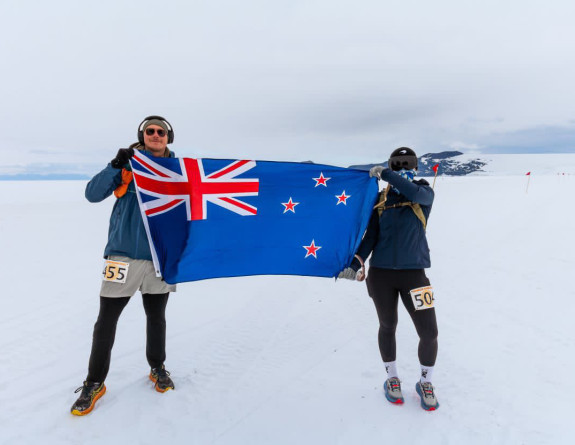
Top shooter right on the mark as he gets his Army career underway
28 January 2025
Unfortunately you are viewing this website on an outdated browser which does not support the necessary features for us to provide an adequate experience. Please switch to a modern browser such as latest version of Google Chrome, Mozilla Firefox, Apple Safari or Microsoft Edge.
Ngā mihi nui
“I’m going to have to call you back in about 10 minutes, we’ve just got an emperor penguin on the runway that we have to shoo away.”
It’s not a typical way to start an interview, and dealing with errant penguins isn’t a typical role for an aviation rescue firefighter, but it’s all part of the job for Leading Aircraftman Pieter Lelieveld, who has been deployed to Antarctica for the summer season.
Leading Aircraftman Lelieveld, from Wellington, has been plying his trade during the ice continent’s summer season for The New Zealand Defence Force’s (NZDF) Operation Antarctica, which is finishing up for the year.
With the penguin safely away from any aircraft coming in to land on the Williams airfield, Leading Aircraftman Lelieveld was at pains to say that while approaching any wildlife in Antarctica is restricted, firefighters have permission to move them along from the runway.
“It’s definitely not something I trained for before coming down, but it’s one of the perks of being down here – we are the only ones who can get them off the runway if a plane is coming in.”
Firefighters spend much of their time monitoring flights coming and going from the ice runway, but also more conventional work like responding to fire alarms, medical events and any fires that break out at McMurdo Station and Scott Base.
Based at United States’ McMurdo Station, Leading Aircraftman Lelieveld said it was an amazing experience being posted to such a unique environment and working with assets from different countries. The team works primarily with aircraft from the United States Air National Guard and Air Force.
Emergencies with the aircraft sometimes happen and Leading Aircraftman Lelieveld said they hit differently in the extreme environment.
“It might be a minor thing like a rudder not performing how it should, but down here that could matter more when it takes off or lands, just because it’s on an ice runway.”
When people starting on their careers look into the firefighter trade, they may not realise they could get the opportunity to work in such an unusual environment, he said.
“It’s a great experience and opens your awareness to see how things are done differently, especially because we are working alongside our United States counterparts and it’s good to see how they do things, which is really beneficial.
“Out at the airfields we don’t have water in our trucks, just foam, because the water would freeze. So we make do with what we have. That was a learning experience how to use it to its best effect. At home we have foam and water and it mixes together to be more effective.”



Leading Aircraftman Lelieveld says he never thought his RNZAF firefighting career would have him shooing away penguins and taking in scientific lectures in Antarctica.
Getting used to the cold was the biggest challenge for Leading Aircraftman Lelieveld, but it wasn’t just people who suffered from the low temperatures.
“Even the vehicles don’t like the cold. There’s not much we can do about that though, if the vehicles don’t start we get a heater next to it and hope for the best,” he laughed.
“When I arrived the temperatures, with the wind chill factor, could reach -35°C. It’s a dry cold though, so it’s more bearable than you think, but if you go out for a hike your face can start to freeze and your face/neck protection will start to freeze with the condensation from your breath.
“But in the peak of summer we were able to wear shorts and singlets – I mean it wasn’t warm, it was still about 0°C, but it was warmer than it had been and we had all acclimatised by then.”
Leading Aircraftman Lelieveld’s enduring memories of Antarctica will be the people and the connections he has made with not just other NZDF personnel, but with the international community who make their homes on the ice continent over the summer season.
“We live in shared accommodation so we have different room-mates that have different jobs and you make connections. It’s not just New Zealanders, it with people from around the world who work down here. Another memory will be the views, they are pretty wild.”
Alongside all the outdoor recreational activities like running a marathon and walking an abundance of nature hikes, another interesting aspect were lectures put on by the scientists every Sunday afternoon.
“They’re really interesting, even though I don’t understand everything they talk about. A lot of the lectures are about the Antarctic wildlife, the rate of ice melts, the geology of the place – they can tell when periods are where the ice has frozen, melted and then refrozen,” he said.
“I feel privileged to be working down here and supporting the scientific research programmes. Even though my role as a firefighter is small, I know I’m directly helping.
“Nothing could really happen down here without us because regulations state there has to be firefighters present whenever an aircraft comes in and nothing would happen down here without the planes.
“People wouldn’t traverse the pole every year and they wouldn’t go to the middle of nowhere to set up camps without us being here. It’s a vital but less-known role for us to be down here. It’s cool to know we’ve contributed to that.
“These are the opportunities that I joined up for, to be able to do this stuff. Not many people get to do it.”